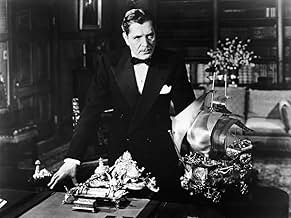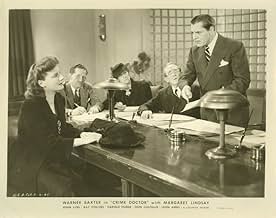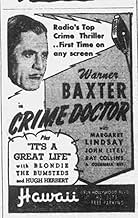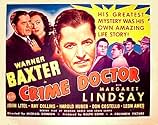Amnesia victim, Robert Ordway, becomes the country's leading criminal psychologist. After he is hit on the head by someone from his past, he suddenly remembers his previous life as a crimina... Read allAmnesia victim, Robert Ordway, becomes the country's leading criminal psychologist. After he is hit on the head by someone from his past, he suddenly remembers his previous life as a criminal.Amnesia victim, Robert Ordway, becomes the country's leading criminal psychologist. After he is hit on the head by someone from his past, he suddenly remembers his previous life as a criminal.
Phil Arnold
- Third Reporter in Court
- (uncredited)
Paul Bryar
- First Reporter in Court
- (uncredited)
Wallis Clark
- Judge
- (uncredited)
Chester Clute
- Headwaiter
- (uncredited)
Kernan Cripps
- Turnkey
- (uncredited)
Harold De Becker
- Bartender
- (uncredited)
Franklyn Farnum
- Juror
- (uncredited)
Featured reviews
With the exception of the Rathbone and Bruce Sherlock Holmes series, this is quite possibly the best of the 'mystery' series of the 30s and 40s. The series begins with this movie as Phil Morgan, master criminal, is double crossed by his gang, beaten and dumped along a roadside. As a result, he suffers from amnesia. This movie, the first of the series, establishes The Crime Doctor's background, explains how and why he became a doctor (a psychiatrist, actually), head of the parole board and helped many convicts find the 'straight and narrow'.
The element that makes this movie and the series in general unique is that it relies on psychiatry and the tendencies of the mentally ill. They often tease you by inserting an obviously unbalanced person and although the plot may lead one to believe that person is the "perp" they may or may not be the actual "perp". Because psychiatry was relatively new and often misunderstood, it provided general insight to the subject. In many ways, the series has yet to become dated although the psychological concepts may appear to be fairly basic nowadays.
A series of factors make this movie series much more enjoyable than others such as The Lone Wolf, Boston Blackie or Bulldog Drummond. The first is the consistency. The quality of the stories in all ten movies remains high throughout the series where the stories of other series tend to deteriorate into standard potboilers after the studio has captured the audience's interest. Second, the same actor plays the lead character in all of the movies. Third, the quality of the supporting cast is exceptional throughout the series. Some of the more recognizable supporting cast includes John Litel, Ray Collins, Harold Huber, Barton MacLane, Jerome Cowan, Reginald Denny, Eduardo Ciannelli, Nina Foch, George Zucco, Ben Weldon, Hillary Brooke, William Frawley, Ellen Drew and last, but far from least, a very young Lois Maxwell who played Miss Moneypenny in at least 15 James Bond films.
However, over the six years the series was shot, one can easily see Baxter's health deteriorating.
The element that makes this movie and the series in general unique is that it relies on psychiatry and the tendencies of the mentally ill. They often tease you by inserting an obviously unbalanced person and although the plot may lead one to believe that person is the "perp" they may or may not be the actual "perp". Because psychiatry was relatively new and often misunderstood, it provided general insight to the subject. In many ways, the series has yet to become dated although the psychological concepts may appear to be fairly basic nowadays.
A series of factors make this movie series much more enjoyable than others such as The Lone Wolf, Boston Blackie or Bulldog Drummond. The first is the consistency. The quality of the stories in all ten movies remains high throughout the series where the stories of other series tend to deteriorate into standard potboilers after the studio has captured the audience's interest. Second, the same actor plays the lead character in all of the movies. Third, the quality of the supporting cast is exceptional throughout the series. Some of the more recognizable supporting cast includes John Litel, Ray Collins, Harold Huber, Barton MacLane, Jerome Cowan, Reginald Denny, Eduardo Ciannelli, Nina Foch, George Zucco, Ben Weldon, Hillary Brooke, William Frawley, Ellen Drew and last, but far from least, a very young Lois Maxwell who played Miss Moneypenny in at least 15 James Bond films.
However, over the six years the series was shot, one can easily see Baxter's health deteriorating.
This was the opening chapter in the Crime Doctor series from Columbia, and as usual the first cut is the deepest. The other nine films veered from lightly sparkling to slightly insipid but all lovely to see - this one was strikingly thought provoking with many memorable scenes scattered throughout. Additionally the production values, acting and plots were of a consistently high standard, and basically Columbia allowed Warner Baxter a six year holiday with the filming of them to help him recover his dodgy health.
A man is tossed out of a moving car as one dead in 1932, turns out an amnesiac who is nursed back to good health by a good doctor who encourages him to become a good friend, good citizen and ultimately a good psychiatrist. He achieves all this by 1943, by which time his shady past is starting to catch up with him, 3 dumb guys eager to reclaim USD 200,000 stolen in his previous life. How it all unfolds and is resolved is as ingenious as the b picture format and the Hays Office could allow. Favourite bits: The 4 of them sitting round the table in Frankie's, all wondering what was going off; Margaret Lindsay almost too exquisite too watch here; Leon Ames, the violent patriot in prison for life then out in a twinkling; the trial of Phil Morgan and Robert Ordway.
It should be an incredibly rewarding 65 minutes to fans of this genre of film, if you find yourself unmoved by it my advice is don't bother with the rest and do yourself and the fans a favour.
A man is tossed out of a moving car as one dead in 1932, turns out an amnesiac who is nursed back to good health by a good doctor who encourages him to become a good friend, good citizen and ultimately a good psychiatrist. He achieves all this by 1943, by which time his shady past is starting to catch up with him, 3 dumb guys eager to reclaim USD 200,000 stolen in his previous life. How it all unfolds and is resolved is as ingenious as the b picture format and the Hays Office could allow. Favourite bits: The 4 of them sitting round the table in Frankie's, all wondering what was going off; Margaret Lindsay almost too exquisite too watch here; Leon Ames, the violent patriot in prison for life then out in a twinkling; the trial of Phil Morgan and Robert Ordway.
It should be an incredibly rewarding 65 minutes to fans of this genre of film, if you find yourself unmoved by it my advice is don't bother with the rest and do yourself and the fans a favour.
Crime Doctor (1943)
** (out of 4)
First film in Columbia's Crime Doctor series has a man (Warner Baxter) thrown out of a car, which leaves him with amnesia. Not knowing who he is, the man decides to start a new life as a doctor but then learns that in his previous life he was a gangster. This was the first film from the series that I watched and I certainly hope they get better. I suspect this film just tells a backstory, which could have been told in the first five minutes of another movie. I found the film incredibly dull and the story itself really wasn't all that involving. Baxter was good in his role but I still wouldn't rank him very high among the countless mystery/detective films of the 30's and 40's.
** (out of 4)
First film in Columbia's Crime Doctor series has a man (Warner Baxter) thrown out of a car, which leaves him with amnesia. Not knowing who he is, the man decides to start a new life as a doctor but then learns that in his previous life he was a gangster. This was the first film from the series that I watched and I certainly hope they get better. I suspect this film just tells a backstory, which could have been told in the first five minutes of another movie. I found the film incredibly dull and the story itself really wasn't all that involving. Baxter was good in his role but I still wouldn't rank him very high among the countless mystery/detective films of the 30's and 40's.
This film is much better than what one might expect, given the studio that made it and the other films of this type put out at the time. Warner Baxter was a good actor, the supporting cast is able, and the writing is taut, uncomplicated and well-done. Direction, lighting and photography are professional. In short, there are few, if any, faults, and the film is well worth a watch. Leon Ames makes an early appearance in a somewhat far fetched sequence involving the rehabilitation of a hardened, bitter convict, but this is a minor, minor flaw in an otherwise very well constructed film. As another reviewer wrote, there are, thankfully, no dumb cops or simple minded assistants, just a well thought out plot and good acting.
I hope that TCM broadcasts more of the "Crime Doctor" series, based on the radio show. Starring Warner Baxter, 1943's "Crime Doctor" is one of the first films Michael Gordon (Pillow Talk) directed, and it's a good, solid B movie.
Baxter plays a criminal named Phil Morgan who gets amnesia after being left for dead on the side of a road. He rehabilitates himself and, still not knowing who he is, becomes a noted psychiatrist named Robert Ordway who works with prisoners as well as other patients.
However, Phil Morgan stole and hid $200,000 and his fellow gang members want the money. As word gets around that Dr. Ordway is Phil Morgan, the question is - does he really not remember, or does he know who he is and where he put the money?
Baxter was 54 years old when this film was made. Fifty-four in 1943 isn't what it is today, so when the character announces that "thirty years of his life" have been wiped out, one wonders which thirty years he's talking about.
The film covers a span of ten years, but it's just as hard to buy he's forty. It's a minor point - Baxter gives a sincere performance with an undertone of real gentleness.
The supporting cast includes the lovely Margaret Lindsay, John Litel (who play Nancy Drew's father in the series), Perry Mason's Ray Collins, and Leon Ames.
Baxter plays a criminal named Phil Morgan who gets amnesia after being left for dead on the side of a road. He rehabilitates himself and, still not knowing who he is, becomes a noted psychiatrist named Robert Ordway who works with prisoners as well as other patients.
However, Phil Morgan stole and hid $200,000 and his fellow gang members want the money. As word gets around that Dr. Ordway is Phil Morgan, the question is - does he really not remember, or does he know who he is and where he put the money?
Baxter was 54 years old when this film was made. Fifty-four in 1943 isn't what it is today, so when the character announces that "thirty years of his life" have been wiped out, one wonders which thirty years he's talking about.
The film covers a span of ten years, but it's just as hard to buy he's forty. It's a minor point - Baxter gives a sincere performance with an undertone of real gentleness.
The supporting cast includes the lovely Margaret Lindsay, John Litel (who play Nancy Drew's father in the series), Perry Mason's Ray Collins, and Leon Ames.
Did you know
- TriviaRay Collins, who plays Dr. Carey in this film, is one of several actors who played the title character in the "Crime Doctor" radio series.
- ConnectionsFollowed by Crime Doctor's Strangest Case (1943)
Details
- Release date
- Country of origin
- Language
- Also known as
- Karanlık mazi
- Filming locations
- Mulholland Drive, Hollywood Hills, Los Angeles, California, USA(Establishing shot.)
- Production company
- See more company credits at IMDbPro
- Runtime
- 1h 6m(66 min)
- Color
- Aspect ratio
- 1.37 : 1
Contribute to this page
Suggest an edit or add missing content


































